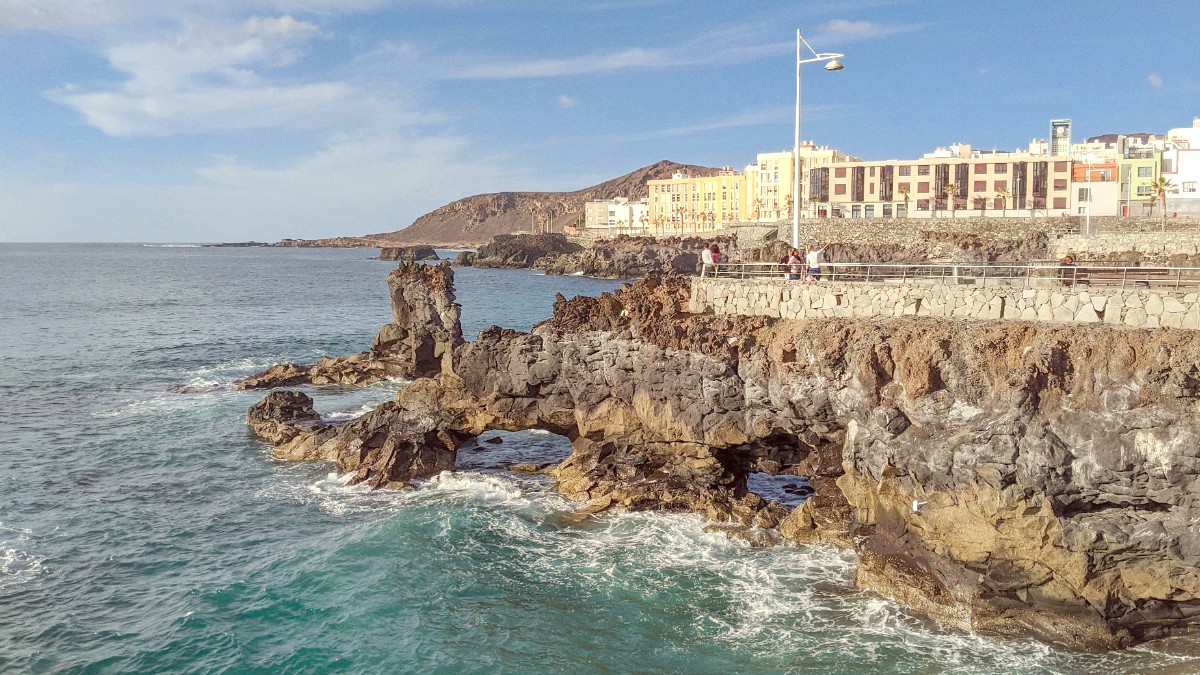
Gran Canaria, Canary Islands
Meal Times: Lunch ("almuerzo") is the main meal, typically 1:30 PM - 3:30 PM. Dinner ("cena") is later, usually 8:00 PM - 10:30 PM or later. Many restaurants do not open for dinner service before 7:30 PM. Eating earlier might mean dining mostly with other tourists.
Tapas: A popular way to socialize and eat. Ordering several tapas dishes to share is common, allowing everyone to taste various flavors. Bread: Often served with meals, sometimes for a small charge. If not desired, politely say "no, gracias." Tipping: As stated in section 2.3, tipping is valued for good service but not mandatory. Rounding up the bill or leaving 5-10% is customary for good service. Reservations: Suggested for popular restaurants, especially on weekends or during high season, to avoid waiting.
Within Las Palmas, a concentration of traditional Canarian restaurants, especially in the Vegueta and Triana districts.
The city's cosmopolitan nature, due to its port history and tourism, also means a wide array of international cuisine options are available, especially in areas like Las Canteras and Mesa y López.
Fresh seafood is a distinctive specialty, with many restaurants near the port and along the Las Canteras promenade presenting the day's catch.
Small, unpeeled potatoes boiled in very salty water until they shrivel and acquire a salty, slightly crispy skin.
Always served with green and red mojo sauces. Find them everywhere.
A hearty and traditional fish stew, typically with salted fish (often cod or "cherne"), potatoes, sweet potatoes, and served with a dollop of gofio.
Frequent in traditional Canarian restaurants, especially on Fridays.
Meaning "old clothes," this Canarian version of the Cuban dish is a flavorful stew with shredded beef or chicken, chickpeas, potatoes, and vegetables, cooked in a rich sauce.
A comforting and savory dish.
Bocadillos (sandwiches), Churros (fried dough pastries with hot chocolate), Empanadillas (small fried pastries), and Pinchos/Tapas (small snacks).
Ron Miel (Honey Rum), Vino de las Islas (Local wines), Tropical/Dorada (Local beers), Barraquito (layered coffee drink), Zumos Naturales (Fresh fruit juices). Iconic desserts include Bienmesabe (almond cream) and Frangollo (milky maize dessert).
Michelin-starred and creative cuisine.
Numerous options in Vegueta, Triana, and Las Canteras. Look for local "tascas" or "guachinches."
For affordable and authentic meals.
A traditional fresh market in the old town. A superb place for local produce, cheese, meats, and authentic local food culture.
Some stalls sell prepared food.
Located near Las Canteras, this modern food market combines various gourmet stalls, tapas bars, and international food options.
It becomes active in the evenings, presenting a social dining experience.
Pasta, pizza, and more.
Japanese, Chinese, Thai.
Cuban, Venezuelan.
Indian, Middle Eastern, and more. Mainly in Las Canteras and Mesa y López areas.
Awareness of gluten-free and other dietary needs is growing. Many restaurants can cater to gluten-free diets, especially if informed in advance.
Learning Spanish phrases (e.g., "Sin gluten" - gluten-free, "Sin lactosa" - lactose-free, "Soy alérgico a..." - I am allergic to...) or carrying a dietary Translation card is helpful. Major supermarkets stock gluten-free products.
Limited options. Halal options might exist in some ethnic restaurants (e.g., Middle Eastern, Moroccan, South Asian cuisine), but dedicated halal or kosher restaurants are rare.
Major supermarkets might carry some certified products, but widespread availability is not typical.
Always communicate your dietary needs clearly and politely. Be prepared for some limitations, especially in smaller, traditional establishments.
Local supermarkets stock a growing range of specialty products, including gluten-free, lactose-free, and organic items, in their dedicated sections.
Become proficient in preparing traditional dishes like "papas arrugadas" and the various "mojo" sauces.
Tapas tours in Vegueta are popular. They offer insights into local gastronomy, history, and the social aspects of dining.
Some local galleries or cultural centers may present workshops in painting, ceramics, or other crafts.
Some rural tourism initiatives in the island's interior try to connect visitors with local traditions and products, including visits to small farms or artisan workshops.
Engage directly with producers for an authentic experience.
Numerous Spanish language schools in Las Palmas serve travelers of all levels, offering immersive courses that blend classroom learning with cultural activities.
This delivers a deep dive into the local language and culture.
One of the largest and most famous carnivals in Spain (February/March), famous for its spectacular Gala de la Reina and Drag Queen Gala.
Celebrates the city's founding day (June 24th) with bonfires on the beach, music, and impressive fireworks displays.
A major religious festival dedicated to the island's patron saint (Teror, September). Its celebration influences the city with various related events.
To truly connect with local culture, check for smaller neighborhood festivals or events. These are often advertised locally or through community centers.